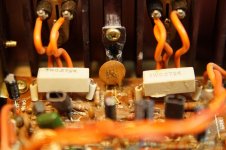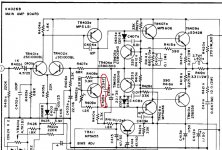What class of ceramic cap is shown in the center of the pic attached?
In the circuit where it is used, can this ceramic cap be replaced with a modern MLCC C0G ceramic? This cap is C405a circled in red, and connects across the emitter and collector of TR404a.
TIA
In the circuit where it is used, can this ceramic cap be replaced with a modern MLCC C0G ceramic? This cap is C405a circled in red, and connects across the emitter and collector of TR404a.
TIA
Attachments
Why replace it? Is it short circuit? or just because you want to.
Anything will work fine in that position. I doubt you will find a 403 or 4nF capacitor anywhere, the schematic calls for 4n7 or 472 which are cheap and readily available.
I would look at C406a if it hasn't been used for a while but I doubt it is faulty.
Anything will work fine in that position. I doubt you will find a 403 or 4nF capacitor anywhere, the schematic calls for 4n7 or 472 which are cheap and readily available.
I would look at C406a if it hasn't been used for a while but I doubt it is faulty.
I need to move that cap to loosen the transistor behind it in order to clean off and replace old thermal grease. I placed a parts order a while back and included new MLCC C0G caps in case I might need them
So I have new C0G caps of the correct value and lead spacing, from Mouser, siting in a bag
Also, the old caps are thicker than the new C0G. Not shown in the pic, but a new Bournes trim pot will fit directly in front of those caps and a little extra space would be nice because it is a tight fit.
Are the old caps XR7?
Will new MLCC C0G caps function as well or better than the old caps in this circuit?
So I have new C0G caps of the correct value and lead spacing, from Mouser, siting in a bag
Also, the old caps are thicker than the new C0G. Not shown in the pic, but a new Bournes trim pot will fit directly in front of those caps and a little extra space would be nice because it is a tight fit.
Are the old caps XR7?
Will new MLCC C0G caps function as well or better than the old caps in this circuit?
Last edited:
X7R were not that widely used when that amplifier was made. Other class 2 ceramics such as Z5U were.
If you hear or measure a difference between caps here, any caps, I’d be very surprised. It probably has those same caps scattered all around the AM/FM section, if there is one.
If you hear or measure a difference between caps here, any caps, I’d be very surprised. It probably has those same caps scattered all around the AM/FM section, if there is one.
Thanks for your replies 
I would NOT be changing the cap in hopes of improving sound in some way.
The old caps will be removed. I will then have a choice of re-installing the old caps, or putting in new C0G.
Does anyone know for certain what type is the old cap? Is there anything special about the old cap which would make it better for this circuit than a C0G?

I would NOT be changing the cap in hopes of improving sound in some way.
The old caps will be removed. I will then have a choice of re-installing the old caps, or putting in new C0G.
Does anyone know for certain what type is the old cap? Is there anything special about the old cap which would make it better for this circuit than a C0G?
Please note WHERE this cap is mounted, right next to the transistor that monitors heat to correct bias.
Is it possible that this cap was used there specifically because it does not have linear temperature coefficient? Are its otherwise less than ideal characteristics being used intentionally for some purpose?
Is it possible that this cap was used there specifically because it does not have linear temperature coefficient? Are its otherwise less than ideal characteristics being used intentionally for some purpose?
No it´s not.Please note WHERE this cap is mounted, right next to the transistor that monitors heat to correct bias.
The capacitor is on the PCB; the temp sensing transistor is attached to Heatsinks.
It´s "right next" only in the schematic.
No, it´s temperature coefficient is irrelevant.Is it possible that this cap was used there specifically because it does not have linear temperature coefficient?
IRRELEVANT | meaning in the Cambridge English Dictionary
not related to what is being discussed or considered and therefore not important:
These documents are largely irrelevant to the present investigation.
Making a large profit is irrelevant to us - the important thing is to make the book available to the largest possible audience.
No.¨Its temperature coefficient characteristics are irrelevant.Are its otherwise less than ideal characteristics being used intentionally for some purpose?
In everyday English: they change nothing. (audible in this case).
There are no markings on the other side.
I am looking at Wikipedia now and see that the "Z" appears only in Class 2 ceramics. Ceramic capacitor - Wikipedia
I don't understand what the 403 or the "SAM" refer to. BTW this cap is .047uF, not nF.
@rayma, is the transistor that this cap connects to the VBE multiplier? Does this cap have an effect on high frequencies? Or does this cap/transistor pair only function to adjust bias in response to temperature changes?
I am looking at Wikipedia now and see that the "Z" appears only in Class 2 ceramics. Ceramic capacitor - Wikipedia
I don't understand what the 403 or the "SAM" refer to. BTW this cap is .047uF, not nF.
@rayma, is the transistor that this cap connects to the VBE multiplier? Does this cap have an effect on high frequencies? Or does this cap/transistor pair only function to adjust bias in response to temperature changes?
No it´s not.
The capacitor is on the PCB; the temp sensing transistor is attached to Heatsinks.
It´s "right next" only in the schematic.
No, it´s temperature coefficient is irrelevant.
IRRELEVANT | meaning in the Cambridge English Dictionary
No.¨Its temperature coefficient characteristics are irrelevant.
In everyday English: they change nothing. (audible in this case).
In everyday English...this cap is physically mounted less than 2mm from the transistor. Thanks for your "help". I don't think I will be needing any more of it in the future.
“403” means 40,000 pf. 4, 0, followed by 3 0’s, in pF. Or the next size up, which would be 4700 pF. If the value isn’t that critical neither is the tempco.
SAM probably refers to manufacturer. I doubt it’s Samsung, Yosemite Sam, or Son of Sam, but it’s probably Sam something.
The transistor responds to temperature changes. There would be no point in the cap responding to temperature changes - the cap isn’t mounted on the heatsink anyway.
SAM probably refers to manufacturer. I doubt it’s Samsung, Yosemite Sam, or Son of Sam, but it’s probably Sam something.
The transistor responds to temperature changes. There would be no point in the cap responding to temperature changes - the cap isn’t mounted on the heatsink anyway.
Sad to see that you still insist on that erroneous concept.Does this cap have an effect on high frequencies?
It does NOT affect high frequencies and in fact 99% of Vbe multipliers work *without* any cap bypassing.
And if they use a cap, it´s typically an electrolytic with way higher value.
FWIW I´m not helping you but some poor soul who reads this thread in the future and gets confused, please do not "read" this another way.
Today one would use a film cap there. A 47 nF (or 0.0047 µF) will do. Make sure to choose one rated double the rail voltage + 20%.
Please replace all other electrolytic caps too as these are very old and must be dried out. Alle values under 10 µf can be replaced for 5 mm pitch MKT caps.
C410a can also be replaced for a film cap (if it already isn't one). C401a, C412a and C413a can all be Wima MKS2 in 5 mm pitch.
About the resistors:.....
Please replace all other electrolytic caps too as these are very old and must be dried out. Alle values under 10 µf can be replaced for 5 mm pitch MKT caps.
C410a can also be replaced for a film cap (if it already isn't one). C401a, C412a and C413a can all be Wima MKS2 in 5 mm pitch.
About the resistors:.....
Last edited:
- Status
- This old topic is closed. If you want to reopen this topic, contact a moderator using the "Report Post" button.
- Home
- Design & Build
- Parts
- What Class of ceramic cap is this and...


